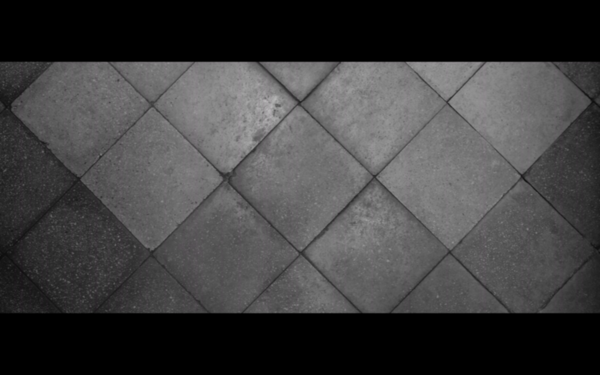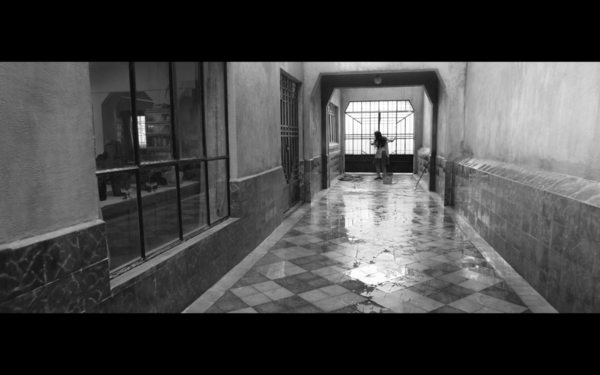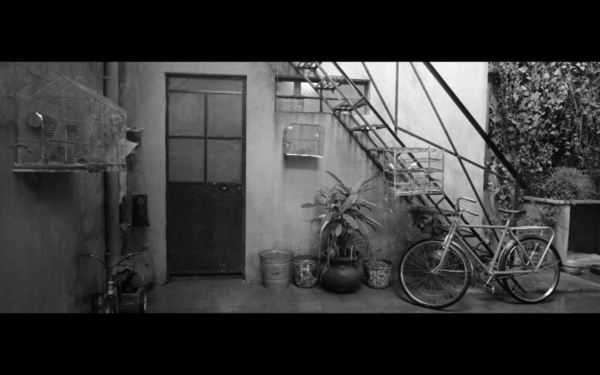SPOILER ALERT!
Roland Barthes’s mother died. As the renowned critic and semiotician reflectively sifted through old photos, he stumbled on an image that floored him: there she was, a little girl, in a “Winter Garden” (i.e., a glassed enclosure), radiating some undefinable quality that, he recognized, would characterize her whole future life. Barthes devotes many pages of his book Camera Lucida to this encounter and struggles to analyze the dynamics at work. As an ineffable event, language ultimately fails him, but he comes closest with a paradoxical summary of his mother’s aura, miraculously and photographically transmitted: “Her assertion of a gentleness.” Lying beyond categorization, much of the power of photography lies not in information, Barthes surmises, but in the ability to poignantly “prick” and “wound” us. So, he calls this effect (and others sharing a similar immediacy) the punctum of the photograph. Some have summarized his now-famous studium/punctum dichotomy to be the social/cultural meaning of a photo vs. its “personal” meaning, but this falls short. It is clear that punctum encompasses more than basic subjectivity. Barthes boldly states that a photograph, with the help of the punctum, can capture a grand illusive truth, amounting to something like “the impossible science of the unique being.”
At the 2018 New York Film Festival, before the screening of his latest film, Roma, Mexican filmmaker Alfonso Cuarón introduced his childhood housekeeper and nanny as “the woman who raised me.” And there she was: tiny, modestly dressed, awed by the crowd before her, gentle, yet obviously steady and strong. She crossed her arms across her heart and took a bow. Just over 1,000 audience members leaped to their feet in a thunderous ovation. Roma, I would discover that evening, is an attempt to recreate the Cuarón family album with the cinema, while reflexively acknowledging the impossibility of such a thing. And what drives Cuarón is the punctum that Barthes articulated many decades before.
Though Barthes assigns the punctum to the unique domain of the still photograph, Cuarón clearly believes he can expand its powers to cinema. For instance, the punctum is often manifest in little, uncontrollable, unexpected details: a curiosity of posture, or even hygiene (dirty fingernails or teeth), or a human hand “at the right degree of openness.” The punctum transcends mere information, social coding, or even aesthetic interest: “I feel that its mere presence changes my reading, that I am looking at a new photograph, marked in my eyes by a higher value.” As if in response, Cuarón’s governing aesthetic for Roma is to keep the frame wide, pack it with detail, keep the camera distant and largely stable, and run the shot long. In many, many instances, there is an object, a gesture, or some other Barthesian detail that keeps us from easy consumption of the image: a Buddha statue beneath a staircase, a boy, in a spacesuit, wandering a forest, a hospital bassinet covered in fallen plaster debris.
In addition, à la Barthes, Cuarón hopes to evoke something of a remarkable woman’s essence, if not her “unique being.” Given the pitfalls of subjectivity atop the difficulties of the medium, this is no ordinary challenge. The film is, of course, Cuarón’s own creation, with an actress as surrogate presence in the image. Yet, at every turn, he makes himself small, so this diminutive character, bearing such presence and dignity through troubles great and small, can loom large.
In this way, the film also functions as a personal confession, and true confessions are not easy. Our memories are the past itself, for us, tangled up in all the self-interest and misguided emotions that got us into trouble in the first place. Confession is surely necessary, but it is always, ever imperfect, and this is why grace is so critical from the offended party. Cuarón asks that of the housekeeper Liboria “Libo” Rodríguez (renamed “Cleo” for the film), and he asks that of us. But make no mistake, this is not mere penance, but gratitude, love, and an attempt to better understand the past.
Cuarón’s personal confession revolves largely around class, and the everyday glosses on the subject that privilege affords a child born into it. Even as a wiser, penitent adult, he can only look back through memory and what he has come to know, through the language he knows best: the cinema.
His artistic confession emerges from a struggle with the medium itself. As a director known for grand flourishes (e.g., the staggeringly long urban battlefield shot in Children of Men, 2006), combined with a penchant for the “post-cinematic” spectacle of digital effects, CGI, and the like (e.g., Gravity, 2013), he makes some cinematic purists cringe.
Roma’s digital effects, however, are so subtle, so well hidden, most audiences will not detect them at all (e.g., all the recurrent and convincing digital airplanes in the sky; he has a penchant for sky/space/flight metaphors). The simulacra here seamlessly merges with other more conventional modes of naturalistic style, which, by contrast, dialectically interact with many of the hallmarks of modern artistic self-consciousness: a moving, independent camera (often slipping between character perspective and some other, independent presence), numerous references to other films (e.g. Fellini’s 8½), and even the occasional quasi-Brechtian moment (e.g., when a drunken man theatrically pauses to sing a song amid a blazing inferno). This grand tension between artist and his subject structures the film. To his credit, however, the subject takes the ascendancy.
All this is evident in the very first scene of the film, which functions like an aesthetic skeleton key to the whole work. We gaze upon a tiled floor, with only quiet, natural sounds in our ears. (In a spirited choice, Cuarón dispensed with a standard musical score for the film.)

It becomes clear we are in for one of his signature long takes, but we also detect more patience regarding the action in the frame. When the camera moves in this film, it typically pans or tilts slowly from an anchored camera position. Outdoor scenes feature more pronounced movement, but usually in a steady, restrained manner. Even tracking movements are most often executed in a directly parallel trajectory to the action and square, perpendicular angle of view, a decision that initially befuddled his longtime cinematographer Emmanuel Lubezki. Later (having stepped away from the project because of scheduling conflicts), Lubezki saw the genius of the choice: “The camera almost becomes like a consciousness.” Cuarón explains it as “the ghost of the present that is visiting the past, without getting involved, just observing, not trying to make a judgment or commentary.”
The film critic Owen Glieberman believes this posture of remove is a flaw, yielding images that are too perfect, “shimmering yet remote . . . like a coffee table book.” But if this is so, it is surely, also, a self-conscious dialogue about memory, ideals, and a culture that comically struggles with forces it cannot fully control. Numerous times this bourgeois tendency is skewered throughout the film. The lampshades are nearly always crooked, the paintings slightly askew. The family cars are constantly being rammed (literally!) into spaces that refuse to accommodate their ridiculous proportions. Cuarón’s accomplished and “cultured” father ultimately favors the fashionable bookshelves over the books themselves. And the family “castle,” which Cleo is charged with maintaining, well, entropy always loiters around the polished surfaces. The dog will not permit anyone to forget that, and we learn, some minutes into the film, this is the ignoble context for the otherwise elegant, meditative opening scene.
In that shot, we look at the floor for nearly three minutes, as credits pulse in and out. This is, indeed, a demand on us, a subtle power dynamic. But, as minimalist artists have long known, unspoken beauty emerges once the will to control an image is broken. And then the transformations begin.
No music cues you as to how you should feel. The tiles stare back at you in their diamond-shaped array, and the pattern creeps up to your consciousness, shifting your attention into a kind of dance between the singular shapes and the whole. It is a subtle, gathering tide of sensations, the way a summer morning steadily blooms into activity. The soundtrack is soft, but full of life: birds, insects, then human footsteps, steady, purposeful, working. The clang of a metal pail hits a hard surface and, unexpectedly, water rushes. A wash of soapy liquid then slips over the surface.

As Claude Monet might have noted, we suddenly have three surfaces: the tile below the water, the surface itself—in all its graceful, ever-evolving forms—and the sky revealed above us. All boundaries between them remain wonderfully porous. The faint sound of an airplane creeps in, and behold there it is patiently gliding across our tiny frame within the frame.

So, we are made to feel, and understand, that the frame is at once limited and revelatory. So much life teems within, under, and over the earth. Even though our frame is so very small, it all might stir us to wonder, and humility, if we would only pay attention.
This perspective also humbles us in a second sense, as an embodied rehearsal for empathy. Cleo (wonderfully played by first-time actress Yalitza Aparicio) spends whole chunks of her day staring at these floors. And like her character, amid all this drudgery, we shall begin to see beauty, hope, and expansive worlds beyond our own. Significantly, this downcast gesture is powerfully inverted in the final (nearly seven minute) shot of the film. We stay anchored precisely where we were, when the film began, but Cleo does not.
The opening shot continues in a straightforward tilt up, where Cleo is shown scrubbing the drive of the home in which we find ourselves, a comfortable, middle-class “palace” in the “Roma” neighborhood of Mexico City.

The camera pans with her as she gathers the hose, chides the dog for his smell (“You need a bath, Borras”), and enters a small bathroom below the servants' quarters. For a solid thirty seconds, we simply wait outside the closed door for her re-appearance. Two birds chirp in their cages, the dog meanders. A bicycle leans against the stairs, an unmistakable evocation of the neo-realist masterpiece Bicycle Thieves (Vittorio de Sica, 1948). That classic film told this story first, Cuarón acknowledges, revealing through patient, empathetic gestures the heart and desperation of the working class.

Cleo emerges, crosses the patio, and enters the main house to begin the many chores that will consume her day; end of shot, end of scene. The entire opening shot has run nearly five minutes.
And, so, intertextual references and other reflexive markers will intermittently appear amid an otherwise “realist” aesthetic. In other words, Cuarón himself will occasionally step forward, but will never raise his voice. In the main, we will see far more emphasis on observation than words, and whole environments will beckon to us with details, textures, and possibilities. When we get to the shantytown, mid-way through the film, the mud feels like it is sticking to our shoes.
Dialogue, when we hear it, will most often emerge from a small part of a wide frame, or off-screen, and close-ups will be reserved for key moments. The camera follows Cleo, never leads her, and the monochrome color scheme also provides necessary space, but only as a kind of reverent signal of the past and a check on the presumptuous urge to over-dramatize another’s life. We all know that color film was plentiful in the 1970’s. Cuarón is not fooling anyone, nor is he trying to. He is just trying to be sure he is not fooling himself.
However, despite the distance he affords on many levels, this revisitation, this witness, still hinges on bodily engagement. We saw this even in the opening shot, in the tidal push and pull of the soapy water. This will prove to be a multisensory pattern throughout, finding culmination in an utterly overwhelming beach scene, near the end of the film. There, the unyielding rhythm of the ocean will threaten to destroy us all.
This is but one example of how the motifs of the film are experientially registered. The climactic moments (and there are more than one) are not the typical products of narrative foreshadowing or deliberate, tension-building ramps of emotion. Rather, they shock us, wound us, as real-world spikes of joy or tragedy usually do: the everyday, completely overturned in an unguarded instant.
And these feelings are complex, appropriate to the bewildering dynamics of life in such a tumultuous time. It is just a living paradox of class dynamics that the oppressed can be co-opted by their oppressors, as we see through the legendary “Halcones” paramilitary organization depicted in the film. Or that that government oppressors could campaign as a party of the people, and still decide to initiate a student massacre. Such was the Institutional Revolutionary Party in Mexico, as hundreds of students died in Mexico City in June, 1971, during the Feast of Corpus Christi, no less. These ironies are not lost on Cuarón, and he makes sure they are not lost on us.
But perhaps the most important paradox in Roma is that ignorant employers can be loved by the servants they so often mistreat. Furthermore, those same employers can come to authentically love their servants as full human beings, particularly when they prove faithful, beyond all reasonableness or expectation. This, of course, justifies nothing regarding class divisions and injustice, but Cuarón’s primary aim is not to preach. He wishes to confess, and (maybe) understand his tangled place within the moral equation. He simply pleads “guilty,” and gets on with the work of standing back, to marvel at the quiet strength of an untutored, under-privileged native woman who upheld so much of his existence.
When we all look back, we so often wish we would have simply paid more attention to everything beyond our narrow frame. Cuarón’s personal remedy is to widen the scene and provide the time and resources to “know the place for the first time.” That, in many respects, is the mystery of the punctum, and the fruit of an honest reckoning.

